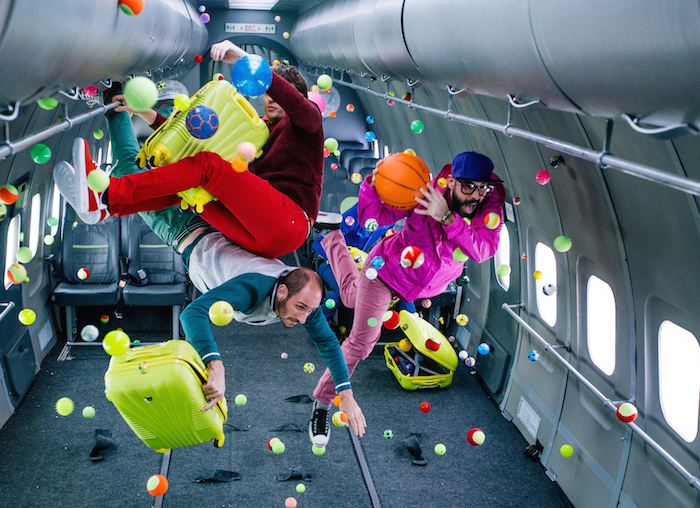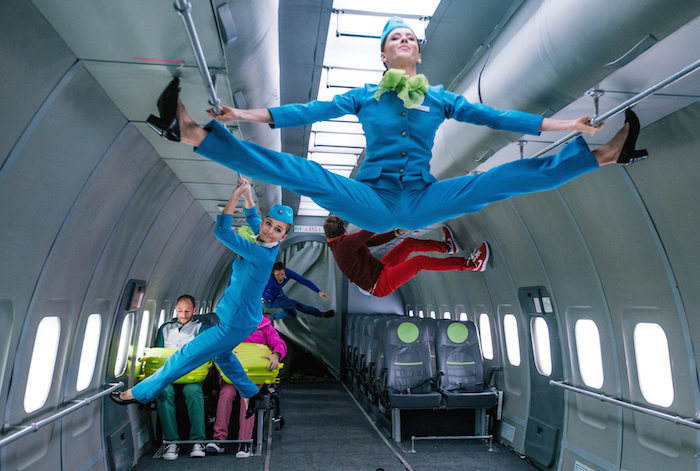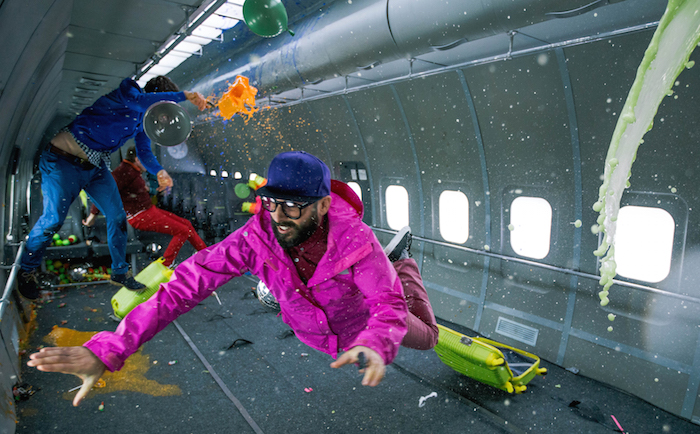
Trish Sie is a director, choreographer, and producer, perhaps best-known for her Grammy award-winning music video “Here It Goes Again” for the band OK Go. In addition to producing and directing films, Sie has done commercial work for clients like Dole, Old Navy, and the Texas Lottery. Sie frequently collaborates with her brother Damian Kulash, the lead singer of OK Go. Together, Sie and Kulash directed “Upside Down & Inside Out” the world’s first zero-gravity music video. Here Sie talks with Victoria Solan about creativity, collaboration, and the pleasures of static art.
++++
Victoria Solan: Congratulations on the gorgeous explosion of Pantone color and post-Soviet airline piñata action is the new OK Go video. In a recent NPR interview, you talked about using fun, rather than achievement as your compass. Why should fun be so important?
Trish Sie: Having fun is critical. Life is so short, the world is so bleak, there are so many headaches involved in every single part of every single person's life—from the stress of morning carpool, to the hassle of keeping up on laundry, to say nothing of the aches and pains of aging, the heartaches we feel when we lose loved ones and watch the evening news. Life is a downer so much of the time, no matter who you are. Finding joy wherever we can, celebrating that joy: it's not just a luxury, it's a survival mechanism.
For me, the process of making something is just as important, maybe more important, than the end product. Whether I'm working with my brother, with my friends, with colleagues, clients, or even strangers, my first order of business is to be sure that we're all on the same team, having a great time. Good things come from creative juices flowing, people feeling safe and inspired. There will be challenges and stresses, of course. But there are rules. Don't be mean, don't scream at people, don't stomp on people's ideas, try to keep your ego out of the way … listen and learn and nurture other people's creativity, build a team, do something jubilant together.
For me, the process of making something is just as important, maybe more important, than the end product. Whether I'm working with my brother, with my friends, with colleagues, clients, or even strangers, my first order of business is to be sure that we're all on the same team, having a great time. Good things come from creative juices flowing, people feeling safe and inspired. There will be challenges and stresses, of course. But there are rules. Don't be mean, don't scream at people, don't stomp on people's ideas, try to keep your ego out of the way … listen and learn and nurture other people's creativity, build a team, do something jubilant together.

VS: How do these collaborations function differently when you do commercial work?
TS: There are important distinctions to be made when I approach various projects. When I'm directing a TV commercial for someone like Texas Lottery or Old Navy, I'm aware that we're representing a client and that client's brand. I'm not at liberty to hijack that. I'm brought on board to lend my ideas, my sensibilities, my technical filmmaking skills, my sense of humor or leadership style. I'm not usually there to make my mark on the world, I'm there to help them make theirs. Music videos often give a director a bit more creative freedom, to go out on a limb artistically. But music videos are still, at the end of the day, an advertisement for a band or musical artist, so I need to be sensitive to how that artist wants to be portrayed. It's always a dance between what they want and what I want. That's why working with OK Go has been so lovely for all of us involved—we have a common goal, a shared aesthetic. It's easy to collaborate.
VS: When do you feel most inclined—and most able—to break aesthetic or creative boundaries?
TS: I'd like to say that breaking boundaries is easiest when you answer to no one except your own vision, whether that's writing and directing your own film or making up dances in the backyard. But being on your own usually means resources are limited, budgets are tiny, and there isn't the urgency and structure that a paid gig brings. Plus, often times, breaking boundaries happens when we're pushed past our comfort zone, dragged past the thing we originally imagined. We go lurching, against our will, into territory we didn't expect to visit. We wander outside of our own imagination and have to find a way for our initial ideas catch up to the unfamiliar landscape in which we find ourselves. That's when I find myself losing sleep over a creative idea, figuring out problems I never dreamed would arise, inventing solutions because I have no other choice. In situations like that, when you feel you're dangling over a creative abyss, it's scary but exciting. You need a team of people you trust. And you need to protect your internal compass, the one that tells you when you're going off course, losing your way, giving up or getting lost. It's so easy to become snow-blind and lost inside a project.
VS: I just watched Geoff Shelton’s “Behind the Scenes: Thunderdome Reel” about the making of “Upside Down and Inside Out.” My stomach is still churning and my fingers are trembling, so let's turn to flat art for a bit. The new OK Go video could be seen as a continuation of a dialogue about contemporary air travel, don’t you think? I’m reminded of the work of Martha Rosler and Nina Katchadourian.
TS: I absolutely adore both of these artists. Nina Katchadourian's lavatory portraits, in particular, have been a source of inspiration for me over and over again. I adore the absurdity, the commitment, and the exquisite magic of making ordinary things extraordinary. It's such a treat to glimpse the everyday banal world through someone else's brilliant, unique imagination. It reminds me to look for that spark of originality and potential in every single thing. It's always there—there's an art project in everything if you keep the channels open.
Whenever I need an idea, I lie on my bed and stare at the familiar pattern of plaster on my ceiling. It always looks exactly the same, but it also always looks different. Forcing myself to be bored and look at this deeply familiar sight usually generates a fresh idea. I think the daily grind of life could serve that purpose for us if we harness it right. The repetition, the predictability, the common experience we share with others daily, it creates a vocabulary from which we can pull. I think that's what Nina Katchadourian is doing with her portraits-- using the ultra-familiar to spark something creative.
VS: Perhaps it's all the flying circles and Russian airspace, but I'm also reminded of Kandinsky’s work of the 1920s.
TS: Intriguing rabbit hole you've opened here! I definitely respond to the playfulness and optimism in Kandinsky's work, the exuberance of color, the energy of his shapes, the emphatically graphic look of his art. I love that the video reminded you Kandinsky, as unlikely as it may seem at first. We definitely made a conscious effort to use a lot of circles. Like many through the ages have noted, circles are so seamless, so perfect, so satisfying. No beginning, no end. No corners, no hard edges. I love the flow of a circle, the momentum inherent in that.
VS: Ok, let’s take it further, then. In 1911, Kandinsky opened "Concerning the Spiritual in Art” with the line, “Every work of art is the child of its age, and in many cases the mother of our emotions.” I think he missed the blood and the vomit, perhaps, but was he onto something?
TS: Art is most certainly the child of its age and the mother of our emotions-- what a succinct and brilliant way to say it. Like I mentioned at the very beginning of this interview, people are bummed out a lot. It's crucial to our survival that we seek joy... that we seek what ties us together and makes us joyful together, at the same time, for the same reasons. There's a lot that drives us apart, pisses us off, and encourages us to focus on our differences. But we can resist a lot of the negative, destructive forces in the world by making art that worships euphoria, exuberance, and optimism. It's not the only sort of art, of course. Art informed by joy maybe not the most important or significant. But without it, I think we'd be sunk.
VS: There's a certain Pop element to your work, as well as a fascination with space, food and mechanical progress. Perhaps it’s the election coverage in the background, but James Rosenquist’s work keep coming to mind as I watch your videos.
TS: I'm a sucker for Pop Art of all sorts, and sign painting in particular. Letters and typography and calligraphy and words are like chocolate pudding for my eyeballs. I could gorge on them and smear them all over my cornea all day. But way beyond that, Rosenquist's collages speak to me in a very real way. I have a similar process when I begin a project. I amass all the things that excite me—flowers, noodles, gears, body parts, the sound of a goat, the feathers of a parrot, the way tequila looks under a microscope, knitting patterns, candy, wallpaper, engine parts, tilework, textiles, sea kelp, and fish scales.
The combination of graphic, colorful, mesmerizing nature juxtaposed with manmade craftiness is always an exciting and stimulating thing for me. For me, the first part of the creative process is like decorating a room, putting the colors and textures and objects I love all around me. I think many artists like to do that with their brains. It just somehow helps fill your mind with the gorgeous things that make you feel good, make you sigh, make you smile. Sometimes you reference them directly; other times they just keep you company and keep you on track while you make something completely different.
Surround your creativity with the things that you think are wondrous.

